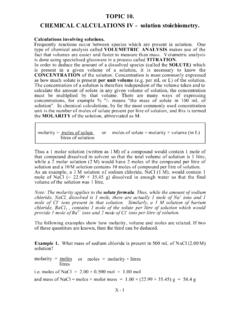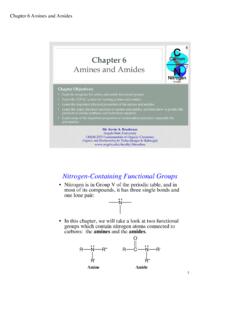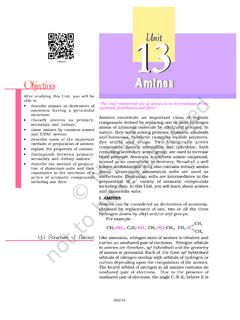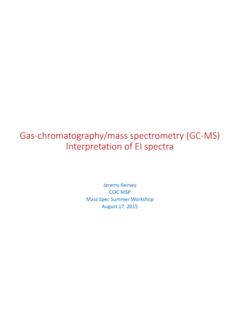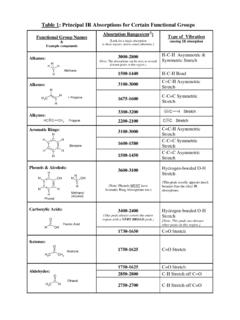Transcription of NOMENCLATURE IN ORGANIC CHEMISTRY
1 1 NOMENCLATURE IN ORGANIC CHEMISTRY Contents 1. INTRODUCTION 3 2. HYDROCARBONS 3 (i) Alkanes 3 A. Unbranched Chains 3 B. Unbranched chains 4 (ii) Alkenes 5 A. One double bond 5 B. More than one double bond 5 C. E/Z Isomers in Alkenes 6 (iii) Alkynes 8 (iv) Combined Alkenes and Alkynes 8 (v) Cyclic Hydrocarbons 9 3. COMPOUNDS CONTAINING HALOGENS AND NITRO GROUPS 10 4. COMPOUNDS WITH FUNCTIONAL GROUPS NAMED AS SUFFIXES 12 (i) General Naming Scheme 12 A. Choosing the Principal Chain 13 B. Naming the Principal Chain 13 C. Numbering the Principal Chain 13 (ii) Naming Various Classes of ORGANIC Compounds 14 A.
2 Ethers and Thioethers 14 B. Alcohols and Thiols 14 C. Acids, Salts of Acids and Acid Anhydrides 15 D. Esters 17 E. Acid Halides 18 F. Amides 18 G. Nitriles 19 H. Aldehydes 19 I. Ketones 21 J. Amines and Ammonium Salts 22 5. aromatic COMPOUNDS 23 (i) General Notes 23 (ii) aromatic Hydrocarbons 23 (iii) Substituted aromatic Hydrocarbons 24 2 A.
3 Halogen and Nitro- Substituted Aromatics 24 B. Carboxylic Acids and Derivatives 24 C. Phenols and Thiophenols 25 D. Aldehydes and Ketones 26 E. Sulfonic acids and Sulfonic Acid Derivatives 27 F. aromatic Amines 28 G. Diazonium Salts 29 6. RADICOFUNCTIONAL NAMING 29 A. Alkyl Halides 29 B. Alcohols 29 C.
4 Ketones 30 D. Nitriles (or Cyanides) 30 E. Grignard Reagents 30 Revised and updated Professor L D Field May 2004 3 NOMENCLATURE IN ORGANIC CHEMISTRY 1. INTRODUCTION It is important that ORGANIC compounds are corrrectly and unambiguously named so that there can be absolutely no confusion about what compounds are actually being reported or described.
5 There have been many conventions for naming ORGANIC compounds - some have had limit scope or become embedded in common usage and some have persisted over time The International Union of Pure and Applied CHEMISTRY ( ) periodically reviews naming practice, attempting to standardise NOMENCLATURE . The following guidelines for ORGANIC NOMENCLATURE are based on the definitive rules published by (the International Union of Pure and Applied CHEMISTRY ). 2. HYDROCARBONS (i) The Alkanes (CnH2n+2) A. Unbranched Chains The first four (n=1-4) unbranched chain saturated hydrocarbons are called methane, ethane, propane and butane. After this, there is a numerical term (of Greek origin) followed by the ending "-ane". The first twelve members are given in Table 1. Table 1. The names of the first 12 linear alkanes n Name Molecular formula Constitutional formula 1 methane CH4 CH4 2 ethane C2H6 CH3CH3 3 propane C3H8 CH3CH2CH3 4 butane C4H10 CH3CH2CH2CH3 5 pentane C5H12 CH3CH2CH2CH2CH3 6 hexane C6H14 CH3CH2CH2CH2CH2CH3 7 heptane C7H16 CH3CH2CH2CH2CH2CH2CH3 8 octane C8H18 CH3CH2CH2CH2CH2CH2CH2CH3 9 nonane C9H20 CH3CH2CH2CH2CH2CH2CH2CH2CH3 10 decane C10H22 CH3CH2CH2CH2CH2CH2CH2CH2CH2CH3 11 undecane C11H24 CH3CH2CH2CH2CH2CH2CH2CH2CH2CH2CH3 12 dodecane C12H26
6 CH3CH2CH2CH2CH2CH2CH2CH2CH2CH2CH2CH3 The group derived from one of these alkanes by removal of a terminal (end) hydrogen is called an alkyl group. The group name is found by removing "ane" from the alkane name and adding "yl". Example: CH3-CH2-CH2-CH3 butane becomes CH3-CH2-CH2-CH2- butyl Note: The free valence must be on the terminal carbon. 1 NOMENCLATURE for ORGANIC CHEMISTRY , Sections A, B and C (combined edition), Butterworths Scientific Publications, London, 1971. 4 B. Branched Chains The following steps are taken in naming an alkane with a branched chain: (a) Find the longest continuous carbon chain and select the appropriate alkane name from Table 1. (Side chains are not included in the carbon count.)
7 (b) Name all of the side chains (carbon chains attached to the longest chain) and list them in alphabetical order. Ignore multiplicative prefixes such as di- (2), tri- (3), "tetra-" (4) etc. Also ignore "sec-" and "tert-" but not "iso". (c) Number the longest chain so that substituents have the lowest possible numbers and insert location numbers before each of the side chain names. Special Note: The following groups have the special names indicated: CH3 CHCH3 isopropyl CH3 CHCH3CH2 isobutyl CH3 CHCH3CH3 secondary-butyl sec-butyl s-butyl CH3 CCH3CH3 tertiary-butyl tert-butyl t-butyl Examples CH3CH2 CHCH2CH3CH3 3-methylpentane CH3CH CH2CH CHCH3CH3CH2CH3CH3 2,4,5-trimethylheptane (not 3,4,6-) CH3CH2CH2CH CH2 CHCH CH3CH3CH3CH3CH3 CH3CH2CH2CH CH CH2CH2CH2CH3CH3CH3 4-ethyl-5-methyloctane (not 5-ethyl-4-methyloctane) 4-isopropyl-2,2-dimethylheptane 5 The following compounds have special names: CH3 CHCH3CH3 isobutane CH3 CHCH2CH3CH3 isopentane CH3 CCH3CH3CH3 neopentane Branched side chains are named by renumbering the alkyl group giving the carbon with the free valence ( point of attachment to the main chain) the number 1 and giving substituents the appropriate number in the usual way.
8 Examples CHCH3CH3CH2CH2 2-methylbutyl group CH CHCH3CH3CH2CH3 CHCH3 1,3,4-trimethylpentyl group The following example gives the name of an alkane having a branched side chain: CH CH2CH2 CHCH2CH2CH2CH2CH3CH3CH2 CHCH2CH3CH3CH2CH2CH3 4-ethyl-6-(2-methylbutyl)undecane (ii) The Alkenes (CnH2n) A. One double bond (a) Find and name the longest carbon chain containing the double bond. (b) Change the ane" of the alkane name to ene". (c) Number the carbon chain giving the double bond the lowest possible location number. (d) Name side chains in the usual way. Examples (note position of numbers and punctuation) 6 CH2 CHCH3 propene CHCHCH3CH3 2-butene CHCHCCH3CH3CH3CH3 4,4-dimethyl-2-pentene Special Note CH2CH2 has the special name ethylene . B. More than one double bond (a) Find and name the longest carbon chain containing the maximum number of double bonds.
9 (b) Change the "ane" of the alkane name to: "adiene" 2 double bonds "atriene" 3 double bonds "atetraene" 4 double bonds etc. (c) Number the chain so as to give the double bonds the lowest possible numbers. (d) Name the alkyl side chains in the usual way. Examples (note position of numbers and punctuation) CH2 CHCHCH2 1,3-butadiene CCHCH2CH CH2 CHCH2 CHCH3CH2CH3CH3 4-butyl-2-methyl-1,3,5-heptatriene Special Note CH2 CCH2 has the special name allene . C. E/Z Isomers in Alkenes In the past, the terms cis and trans have been used to differentiate the isomers; cis to indicate the isomer in which the substituents are on the same side of the double bond, trans when they are on opposite sides. This NOMENCLATURE is still used in some older texts, however, the approved NOMENCLATURE for alkene stereoisomers involves the prefixes Z- or E.
10 There are two substituents attached to each of the carbon atoms which form a C=C. The carbon atoms at either end of the C=C are considered separately and at each end, the two attached substituents are ranked according to a simple set of priority rules (or sequence rules). The priority of the two groups attached to each carbon atom of the C=C is based initially on the atomic number of the atom at the point of attachment. For example, a chlorine 7substituent would have a higher priority than a CH3- which in turn would have a higher priority than a H-. When the C=C is considered as a whole, if the groups with the highest priorities are on the same side of the double bond then the name of the alkene is prefixed with a Z (from the German 'zusammen' meaning 'together'). If they are on opposite sides then the prefix is E (from 'entgegen' meaning 'opposite').



